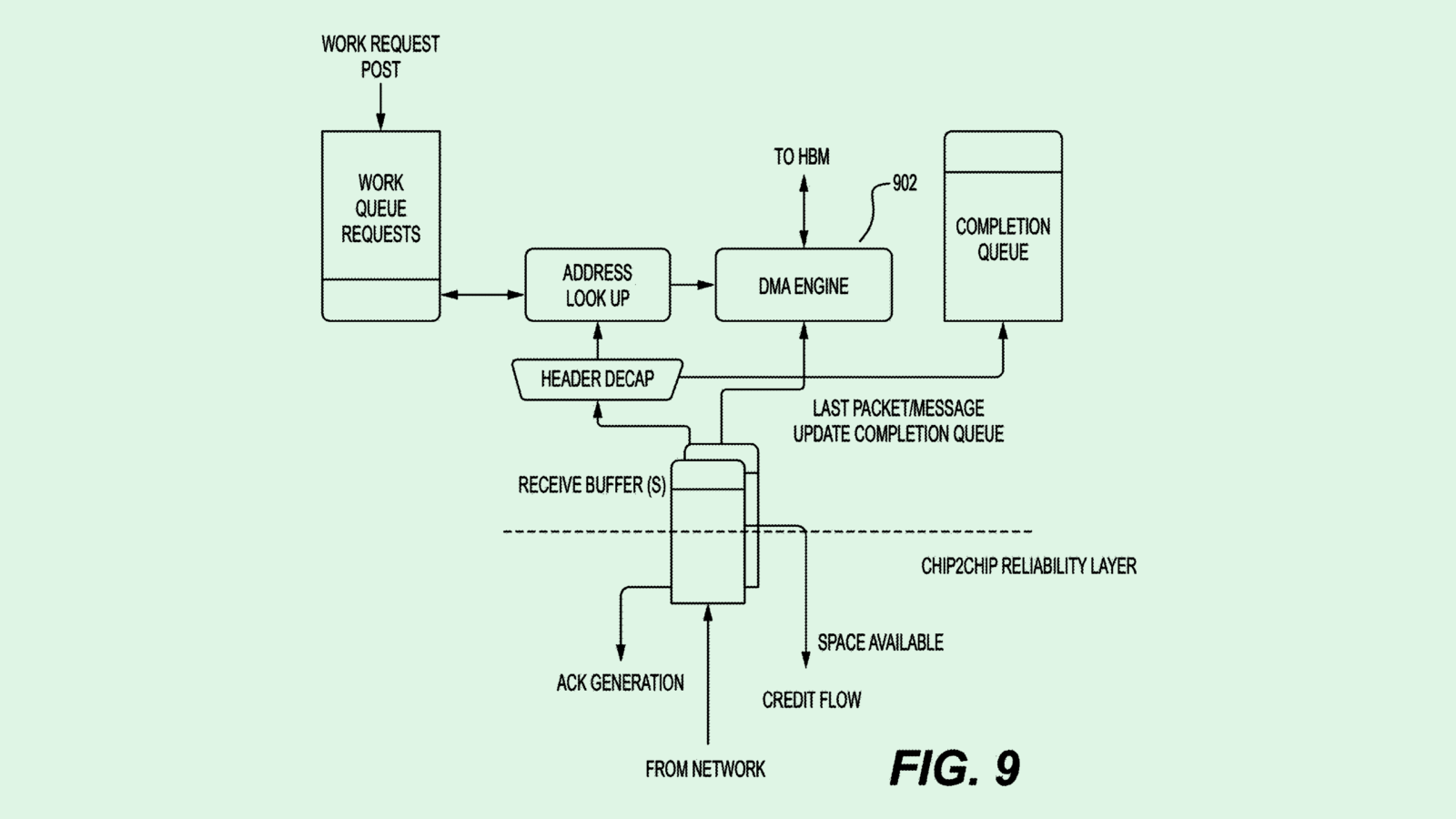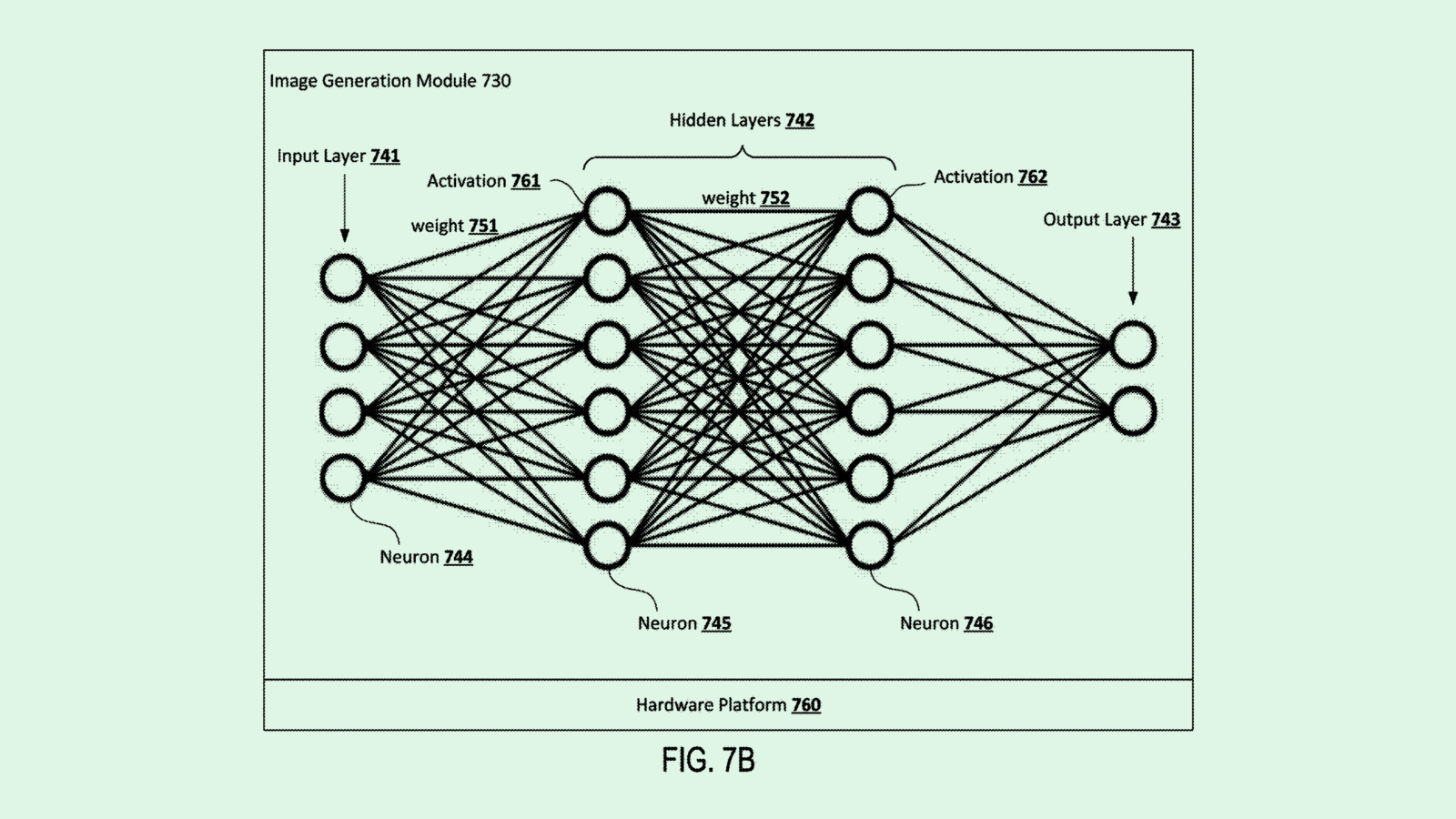Happy Monday and welcome to Patent Drop!
Today, a patent for AI chip architecture from Meta could make model development more robust as it builds AI tools for businesses. Plus: Salesforce is bringing an artistic flair to the enterprise; and Ford authenticates your face.
First, a quick programming note: Patent Drop will be off on Thursday, November 28, for Thanksgiving.
Let’s get into it.
Meta’s Business Bet
Meta is powering up its AI capabilities for business users.
The company is seeking to patent what it calls “chip-to-chip interconnect with a layered communication architecture.” To put it simply, this is a hardware patent that will enable more reliable, scalable and efficient AI systems for handling complex tasks.
“Large numbers of processing units are oftentimes connected for large-scale computing tasks,” Meta said in the filing. “However, these processing units are oftentimes connected in a manner that does not scale well with network speed growth and/or involves cumbersome communication protocols.”
Meta’s patent is quite technical, but to break it down: Several integrated circuit packages each contain AI chips and a “chip-to-chip interconnect communication unit,” which manages the data exchange from one bundle of chips to the next.
This communication relies on “ethernet protocols,” which are known for the reliable, high-speed exchange of data. These protocols are completed via a “layered communication architecture,” which breaks down communication into several tiers to make the process more efficient. Each is responsible for a different part of the data transfer process – one to handle data transmission, another to handle data integrity, and another to manage final delivery.
Finally, Meta’s tech uses what’s called “credit-based flow control,” which makes sure that data is only exchanged when systems have the capacity to receive it. Any data that’s lost or corrupted in the process of being transferred between circuit packages is retransmitted.

The capabilities of Meta’s tech system more than the tech itself: Making communication between AI architectures more robust as a means of handling increasingly complex and data-intensive tasks.
By creating architecture that promotes seamless communication between GPUs, tech like this could broadly support Meta’s AI efforts, whether it be building out its artificial reality tech or creating a robust foundation for Llama, its group of language models, said Thomas Randall, advisory director at Info-Tech Research Group.
“If you end up with a model where you’re bringing in new chips that can’t communicate with your legacy ones, then you’ve lost a lot there,” said Randall. “[This can] maintain the seamless flow of data as new chips are being created.”
And Meta’s AI work may soon take a turn into enterprise: The company hired Clara Shih, former CEO of AI at Salesforce, to lead its new Business AI unit, which will focus on building AI tools for businesses that use Meta’s apps to reach consumers.
“Our vision for this new product group is to make cutting-edge AI accessible to every business, empowering all to find success and own their future in the AI era,” Shih wrote in a LinkedIn post last week.
It’s clear why Meta may be turning its attention to business tools, said Randall: The company has spent a whole lot of cash building strong foundational models to rival the likes of OpenAI, Google and Anthropic. Now, “they’ve got to show returns in some way,” he said. “The natural next step is to try and commercialize [its models].”
Meta, however, may be a little late to the game. The market is flooded with enterprise AI tools from Big Tech and startups alike. While Meta has the advantage of Llama being an extremely capable language model, Randall said, “they don’t have the first-mover advantage.”
“[Meta] needs to showcase what the unique value proposition is of the Llama model versus OpenAI or Gemini or all these other ones,” said Randall. “It might be better in some senses. But is that marginal, or is that significant enough to make this switch?”
Salesforce Gets Artsy
Salesforce wants its AI to be picture perfect.
The company is seeking to patent a system for “controllable image generation,” technology that essentially builds guardrails into AI image generators to prevent them from running amok when asked to do several different tasks. Salesforce’s tech deals with diffusion models, which are primarily used in image generation.
Existing methods “exhibit poor performance when attempting to use the same [diffusion model] for multiple different tasks,” Salesforce said in the patent application. “Training or fine-tuning a separate [diffusion model] for each task is expensive in terms of memory and computation.”
Salesforce’s tech combines the capabilities of two models: one a pre-trained, fixed diffusion model and the other a trainable diffusion model for task adaptability. This flexible model may start as a copy of the fixed one, but with trainable parameters.
The pre-trained, fixed model is the core of the system, while the adaptable model works in tandem with it to modify image generation. When this model receives an input image and a task description, the flexible model basically fine-tunes specific layers of the fixed model to make the output more relevant to the task.
The design cuts the need to create separate diffusion models for different tasks, creating one unified image model that’s adaptable to multiple requests.

The innovative design of the system could overcome a common issue that image generators face, said Bob Rogers, Ph.D., the co-founder of BeeKeeperAI and CEO of Oii.ai. With typical image models, “you have to try a whole bunch of different prompts until you get the thing you like,” said Rogers. “It just is not systematic at all.”
With this system, rather than finally arriving at the right image via “trial and error,” a “tunable controller” could be applied to diffusion models that allow for subtle and more efficient tweaks to images, he said. Imagine it like a knob that you can adjust to change an image, he said, instead of starting from scratch.
In an enterprise context, an easily-adjustable image could expand Salesforce’s offerings for marketing and creative campaigns, said Rogers, saving time and resources so you don’t need to “cross your fingers” for a good outcome.
“You can’t ask people to randomly hope for the right kinds of graphics,” he said. “I think that control knob idea is actually very potentially compelling.”
The concept could also fit in with Salesforce’s broader push toward agent-based AI, said Rogers. As the company seeks to make interfacing with agents as easy and intuitive as possible, allowing customers to get to their desired outputs with minimal back and forth could make its products more desirable, he said.
“You could imagine with specific enterprise agents that are all about generating images, that Salesforce is going to be excited to have this tunable graphics-generation capability,” said Rogers.
Ford’s Face Scanner
Ford wants to make sure it’s you behind the wheel.
The automaker filed a patent application for “scene authentication,” which essentially enhances security in vehicles by making the facial and biometric recognition systems more robust.
“In some situations, such [as] an unauthorized individual attempting to operate the vehicle, the individual may attempt to tamper with a captured image depicting facial and/or other features,” Ford said in the filing.
To avoid this, Ford’s tech tracks “illumination patterns,” such as shadows and light: The system captures not only the driver’s face, but the entire “scene” around them, such as a vehicle’s interior and other objects in a frame, tracking the light patterns in the scene. These light patterns are then compared to previously captured images and biometrics.
If the light patterns in the scene as a whole do not match with that of previous scenes, Ford’s tech may determine that tampering or fraud have been employed to imitate the vehicle’s actual owner.
For additional security, all captured biometric data is stored in a secured, encrypted memory that’s only accessible by authorized parties, Ford said.

Though this tech is positioned as a means of providing an added layer of security, the ability to identify who is in the driver’s seat could have multiple use cases, said Bob Bilbruck, CEO of consulting firm Captjur.
In a situation where there are multiple known drivers, it could automate personalization features, such as seat positioning, AC or music. If the driver is younger, it could automatically implement additional safety features, he said. “I think this is going to be a quick way to reference everybody in the car,” said Bilbruck.
For automakers, the benefit of tech like this is clear: It’s a “marketing upcharge,” said Bilbruck. “Every service in the car is going to be something you can easily opt into with your face.”
This filing brings up a growing question as vehicles become more connected, personalized, and eventually autonomous: Where is the line between convenience and privacy? While tech like this could make day-to-day life easier, Bilbruck said, the cost is giving personal data to yet another company. “Nobody is going to have any privacy anymore,” he said.
Plus, given that lots of these facial recognition and biometric services often rely on AI as part of their foundational tech, they are far from perfect, he said. AI still has a tendency to hallucinate, lean towards biases and make mistakes. “These systems are great until they’re not,” Bilbruck noted.
Extra Drops
- Adobe wants you to have the perfect soundtrack. The company filed a patent application for “natural language-guided music audio recommendations” for video.
- Apple wants to make sure its Vision Pro can breathe. The company is seeking to patent “head mountable display ventilation.”
- Disney wants to make sure its AI characters are up to par. The company has requested a patent for a system for “entertainment character interaction quality evaluation and improvement.”
What Else is New?
- The Australian government withdrew a bill that would fine social media platforms for failing to curtail misinformation.
- Intel’s funding from the CHIPS act was cut from $8.5 billion to under $8 billion, in part to account for a multibillion-dollar contact with the U.S. military.
- Bluesky’s daily active users popped 300% to 3.5 million following the election as users sought alternatives to X.
Patent Drop is written by Nat Rubio-Licht. You can find them on Twitter @natrubio__.
Patent Drop is a publication of The Daily Upside. For any questions or comments, feel free to contact us at patentdrop@thedailyupside.com.
